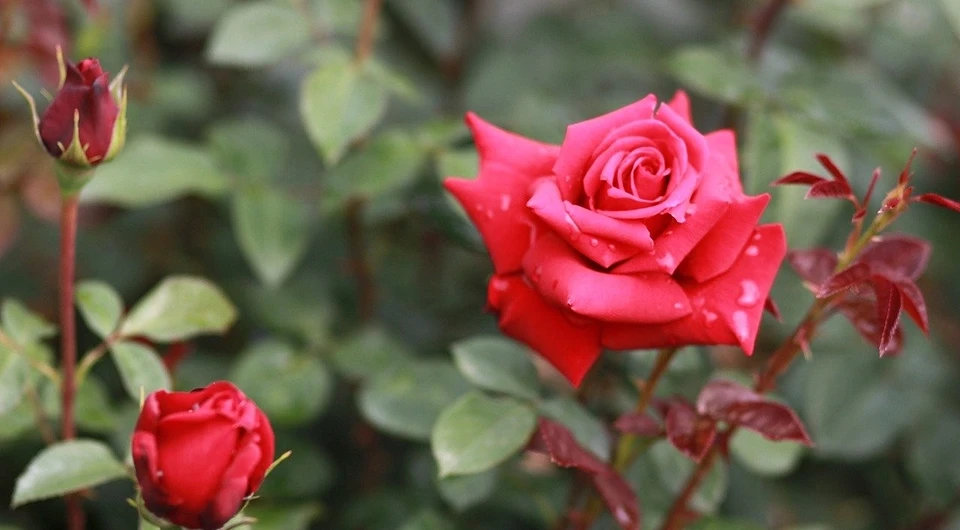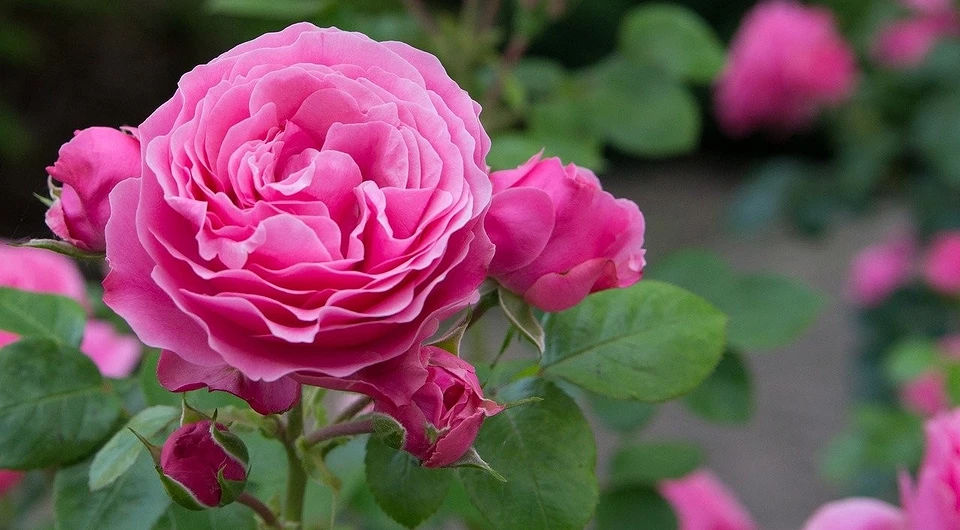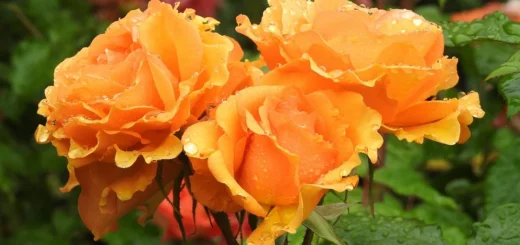Caring for roses in spring: a simple 6-point checklist to follow after winter

We provide detailed information on all spring activities—feeding, pruning, transplanting, and other steps necessary for the full growth and lush flowering of rose bushes.
With the arrival of the first days of spring, it’s time for gardeners to start caring for their rose gardens. Following the rules and instructions, and taking into account the area’s climatic characteristics, will allow each bush to bloom profusely for at least 10 years. Let’s figure out what kind of care roses need in the spring.
All about spring care for rose bushes
Only healthy and well-groomed bushes bloom profusely. Therefore, gardeners need to carry out all spring activities correctly and on time. It is necessary to prune, feed, transplant, plant, and protect plants from diseases, etc. To make sure you don’t forget anything, we have prepared a simple six-point checklist.
1. How to remove winter cover correctly
The flowering time depends on when the winter cover is removed. This should be done after the soil inside it has thawed. This is a general rule for all climatic zones. You should not be late or rush. In the first case, the plant is at risk of excessive moisture and rotting, and in the second, freezing.
When to remove
| USDA Zone | Example Regions | When to Remove Winter Protection | Recommended Air / Soil Temperature | Notes |
|---|---|---|---|---|
| 3 | Northern Minnesota, North Dakota, Maine | Late April – Early May | Air: consistently above 41°F (5°C); Soil: > 40°F (4°C) | Wait until the risk of hard frost (below 23°F / -5°C) is gone |
| 4 | Wisconsin, Northern Iowa, Vermont | Mid – Late April | Air: 45–50°F (7–10°C); Soil: > 42°F (6°C) | Remove gradually as temperatures stabilize |
| 5 | Illinois, Nebraska, Pennsylvania | Early – Mid April | Air: above 45°F (7°C); Soil: 45–50°F (7–10°C) | Nights should stay above freezing (32°F / 0°C) |
| 6 | Kansas, Missouri, Kentucky, Maryland | Late March – Early April | Air: 50°F (10°C); Soil: > 46°F (8°C) | Ensure the soil is thawed completely |
| 7 | Virginia, Tennessee, Oklahoma, New Mexico | Mid – Late March | Air: 55°F (13°C); Soil: > 48°F (9°C) | Ventilate gradually before full uncovering |
| 8 | North Texas, Georgia, Oregon | Early – Mid March | Air: > 55°F (13°C); Soil: > 50°F (10°C) | Minimal protection is usually needed |
| 9 | Southern California, Florida, South Texas | February | Air: > 60°F (16°C); Soil: > 55°F (13°C) | Remove light mulch or covers at stable warmth |
| 10–11 | South Florida, Hawaii | Not required | — | Roses grow year-round; no winter protection needed |
If roses have overwintered uncovered, which is possible in warm regions, care must be taken to protect them from over-moisture. With the onset of intense melting, drainage ditches are dug to prevent meltwater from stagnating in the trunk circle. Otherwise, the roots will start to rot. Bushes that have been covered for the winter should be uncovered.
How to uncover bushes correctly
- Ventilation should begin after the snow has completely melted and stable warm weather has arrived. If this condition is met, the cover should be opened slightly for 3 to 4 hours each day.
- Partial uncovering is carried out when the soil thaws to a depth of 0.49 feet (150 mm). The shelter is removed from the east and north sides.
After three days, the shelter is completely removed. But only if the weather is dry and windless. The bushes cannot be left completely uncovered. The root system has not yet fully awakened and is not functioning well. Therefore, the stems cannot tolerate ultraviolet radiation. To prevent sunburn, they are shaded. For this purpose, spruce branches, paper, or any thin agrotextile are used.

How to remove winter cover correctly | Pixabay
After a few days, when the bushes have adapted to the sunlight, the shade is removed. Now it is time to hill them up. Experienced gardeners advise wearing protective gloves and carefully hilling the stems by hand. This will keep the young shoots intact. After that, loosen the soil in the trunk circle. Lubricate the areas where the cuttings were grafted with a 1% solution of copper sulfate.
2. How to solve problems after wintering
After winter, all plants must be carefully inspected. During this period, areas of disease, rotten or frozen shoots, become visible. Frozen branches dry out and take on an unnatural brownish-brown color. They should be cut out immediately. Reddish-brown spots on shoots indicate that they are “rotting.” This is the result of over-watering, caused by the late removal of the cover.
At first, the brown spots are uniform, then their centers become darker. If left untreated, they quickly spread along the branch. The infected shoot is cut out and replaced with a completely healthy area. The cut material must be burned. The cut area should be thoroughly treated with a copper-based fungicide. Copper oxychloride, for example, will help. If the spots have already spread throughout the plant, it should be uprooted and burned.
Sometimes cracks of various sizes appear on the branches. The reason for this is a warm autumn. The movement of sap slows down in such conditions, but does not stop. When the first frosts come, the liquid freezes and breaks the wood. Such defects must be treated with copper sulfate or a potassium permanganate solution. Cracks are filled with garden var. If the shoot is severely deformed, it is removed.

How to solve problems after wintering | Pixabay
Mold on overwintered flowers appears as a result of the lack of autumn treatment. Mold should be removed by simply wiping it off. Then treat the problem areas with iron sulfate or soapy water with added copper. Sometimes it seems that the bush is dead. There are no sprouts on it. Gardeners advise shaking the plant. If it wobbles, the root system has most likely died and no longer holds it. Otherwise, there will be no wobbling.
3. When and how to plant roses in spring
Around mid-April, before the buds have sprouted, you can transplant and plant. First, could you choose a location? It is best to grow on the south side, where it is sunny and open. Cold winds are undesirable. Could you plant the seedling in a prepared hole and make sure it’s shaded?
Please don’t water or disturb it for the first five days. After this time, watering and subsequent feeding are possible.
Spring grafting is considered the most effective, as the graft has time to take root before the cold weather sets in. It grows better with the rootstock during the incredible season, and if unsuccessful, the bush can be grafted again in the summer. Let’s consider, for example, how to graft a rose onto a rosehip in the spring. There are no restrictions on the choice of method, but most gardeners prefer the “behind the bark” and “applied” methods. The rosehip is cut down to a stump, on which a longitudinal cut is made in the bark. This is done so that it goes slightly deeper into the stem. Then a small transverse cut is made. The prepared bud is inserted into place and secured.
The quality of the grafting material is essential. Therefore, it is crucial to plan how to preserve rose cuttings until spring. They are harvested in late autumn or winter. They are kept wrapped in plastic in a cold place, such as a basement, a refrigerator, or buried in snow.

When and how to plant roses in spring | Pixabay
4. How to prune roses in spring
Rose bushes must be pruned in spring. Pruning is carried out in two stages. First, sanitary pruning is performed, and only then formative pruning. The purpose of sanitary pruning is to remove old or deformed branches. Shoots that grow inward are removed immediately. For grafted plants, it is essential to remove all shoots that appear below the grafting site completely. All cuts are immediately treated with brilliant green or garden variety.
Rules for sanitary pruning
- The shrub is pruned every spring.
- All manipulations are performed before the buds bloom.
- Cut correctly 0.02 feet (5-6 mm) above a healthy bud at a strict 45° angle.
- Use sharp pruning shears for the procedure. Disinfect the shears after treating one plant.
Formative pruning is done later. Its purpose is to activate shoot growth and form an attractive crown. Early-flowering varieties are formed in April, before any leaves appear. Ground cover, climbing, and tea-hybrid varieties are pruned in May.
Types of formative pruning
- Light. Ten buds are left on the branch. They will subsequently develop into small shoots; this is done with park and climbing varieties. Flowering occurs in June.
- Medium. Seven buds are left. The resulting branches are longer than after light pruning. But they will also bloom later. Almost all varieties are treated this way.
- Strong. Three buds remain. They produce powerful, long branches. Flowering is delayed by a month.
The last type of pruning is not suitable for climbing varieties. They do not have time to bloom. Old bushes are pruned in this way. This allows them to renew themselves and has a rejuvenating effect. Each variety requires a specific type of pruning. For example, only light pruning is recommended for shrubs, standard trees, and park trees. Six buds are left on remontant varieties. Ground cover plants are only subjected to sanitary pruning and, as they mature, to rejuvenating pruning.

How to prune roses in spring | Pixabay
5. How to feed roses in spring
In spring, rose bushes need additional nutrition, including phosphorus, magnesium, nitrogen, and potassium. You can feed them with mineral, organic, or complex fertilizers. Once you have chosen the composition, be sure to read the instructions and apply the fertilizer exactly as directed. You can make your own universal mineral mixture. Mix equal parts of ammonium sulfate and ammonium nitrate.
The resulting mixture is applied to the soil around the trunk at a rate of 0.01 lb/ft² (30 g/m²). This method is used for moist soil. If the soil is dry, fertilize at the root. In this case, prepare a liquid fertilizer. Dissolve the mixture in water before watering. A good option for feeding roses in the spring to promote lush flowering is organic fertilizer. A layer of soil 1.97-3.94 inches (50-100 mm) thick is removed from under the bush. Humus or compost is poured into its place.
6. How to protect plants from pests and diseases
Spring care must include preventive measures to protect against pests. For these measures to be effective, they should not be started immediately, but after four to five consistently warm, sunny days. Before the first treatment, the soil in the rose garden is loosened. Insects that emerge from the ground to warm up will do so in the loosened area where the treatment is being carried out. It is intended for the soil. A week later, a second treatment is carried out, this time for the plants and soil.
Complex action preparations are selected, most often copper-containing. Insecticides and fungicides are mandatory for plants. It is essential to ensure the composition follows the manufacturer’s recommendations. You can use folk methods. For example, a good protection against diseases is a mixture of water and kerosene: 1 tsp per 2½ gallons of kerosene.

How to protect plants from pests and diseases | Pixabay
Proper care of roses in the spring after winter is critical. It allows the flowers to emerge from hibernation and enter an active phase of growth and flowering. A novice gardener may find it troublesome to carry out all the necessary measures. However, they cannot be neglected. The rose bushes in your garden will reward you for your care with lush, bright flowers.
❓ Questions and answers
How often should I fertilize my roses after winter?
Apply fertilizer about 4–6 weeks after the last frost, then again mid-spring, and once more before summer heat sets in. Use a balanced rose fertilizer or organic compost, following the package instructions to avoid overfeeding.
What type of pruning is safe in early spring?
Start with sanitary pruning by removing dead, diseased, or damaged wood. Cut back to healthy tissue at a 45° angle. After that, you can do formative pruning by selecting which shoots to keep, always before new buds break.
How do I protect rose bushes from pests and diseases after winter?
Once you've had several warm, dry days, remove debris and loosen soil. Use preventive sprays, such as copper-based fungicides or organic options. Monitor for early signs of black spot, powdery mildew, or aphids, and treat promptly.
Can I transplant or replant roses in spring, and how?
Yes — early to mid-spring, before buds emerge, is a good time to move roses. Choose a sunny location, dig a wide hole with enriched soil, water thoroughly after planting, and avoid disturbing the roots for a few days. Mulch lightly to retain moisture.
Sofia Lorenson: An expert in floriculture and floristry with 10 years of experience. I will help you create the garden of your dreams, which will bloom from spring to fall.
See also
What cannot be planted together: incompatibility table, cheat sheet for gardeners
How to plant grapes in autumn: planting instructions and care tips
Pruning roses in autumn: timing, diagrams for seven different types, rules, and tips
When to transplant roses in autumn: timing, rules, and valuable tips
Bright hedges: how to combine shrubs with their surroundings
How to propagate a rose: rules, five effective methods with photos













